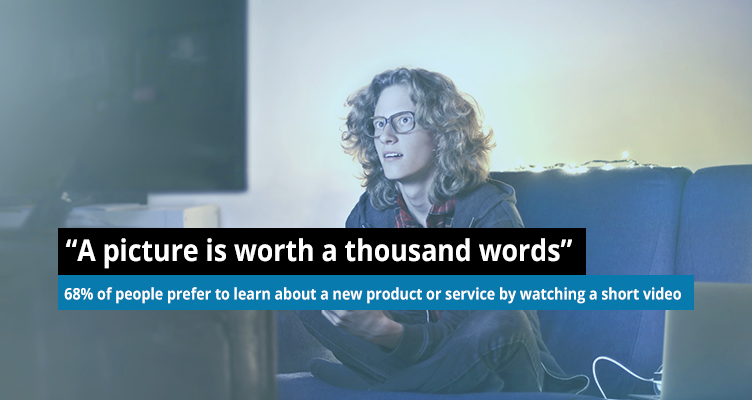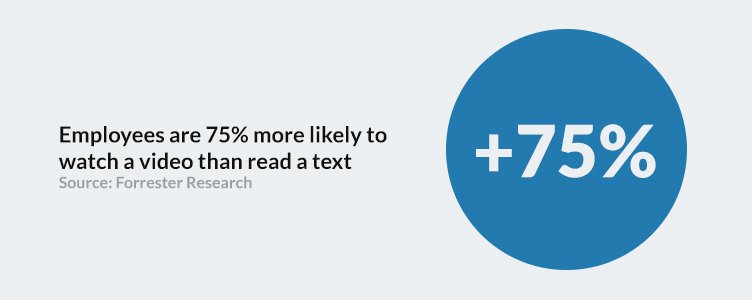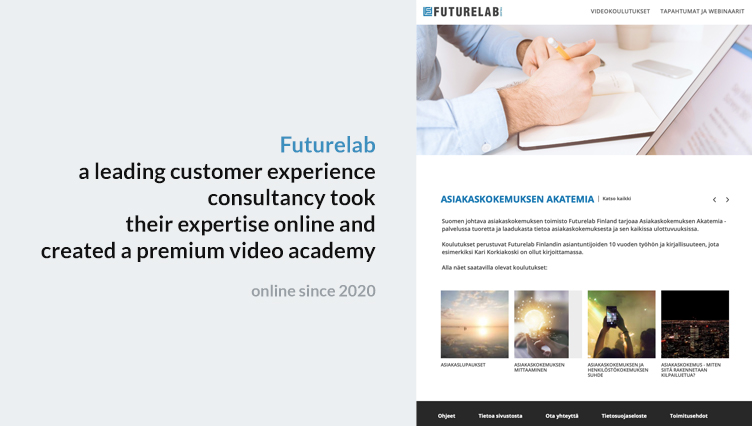5 reasons why you should build a video academy
blogs, Icareus Suite, Solutions and Cases for Enterprises, Solutions and Cases for Event and Webinar Organizers2020 changed the way we do business, meet people and live our daily lives. One of the outcomes of the pandemic is the explosion of online events, trainings, webinars and live streaming as well as other video consumption. Zooms, GotoWebinars or Teams are no longer enough to produce a premium online video experience. Event participants do not want to install 3rd party software and demand for a brand safe environment. The time of video academy is here.
To put it simple, video training is the new normal.
I believe that anyone who has responsibility in training (internal or customers) should be publishing online videos as part of their education program. A video academy is a great place to centralise your efforts.
I am quite confident that after reading this, you agree with me.
1. We are all professional TV watchers
We all know how to use TV, we love to watch TV (or more generally video). We talk and discuss the programs we see and remember movies even after 10 years. Interestingly, it has a theoretical background The “Pictorial Superiority Effect”*. It states that we remember better the received information if pictures and words are used together.
Specifically, after 3 days, we tend to remember 10% of the information we saw in word format whereas we tend to remember 65% of the information we saw in both picture and word formats.
There is the old saying: “a picture is worth a thousand words”. It surely has its merits.

How does that matter for online video then?
From a B2B perspective this all comes down to the fact that 68% of people prefer to learn about a new product or service by watching a short video (The State of Video Marketing 2019).
If fact, according to a Pew Research study, 87% of users said that YouTube is important for helping them figure out how to do things they haven’t done before. YouTube clearly works, but the question is: would you rather have people on your video academy and embrace them with your videos, products and services?
The motivation and demand to use video in training is out there. Also alone, but at least to complement the classroom training.
2. Videos offer better engagement.
You, as a trainer, surely want to reach as many students as possible, right?
Videos can play a vital role in your training syllabus, because employees are 75 percent more likely to watch a video than to read documents, emails or web articles (source: Forrester Research).
To continue to use YouTube as an example (or perhaps competitor to you). Learning and educational content drives over a billion views a day on YouTube. Probably there is any other source of educational content that can boast with a number like that.
I think one of the main reasons for the high engagement number is the fact that people will remember 20% of what they read and 80% of what they watch (source: Assignment Masters).
Next you say that not all learn by watching. Correct, and according to research conducted by employee training experts at AssignmentHelper.com.au, different people do indeed learn and absorb information differently. Some prefer audio, while others ingest information by watching. But think about it, video serves both groups, and with subtitling you can even read while watching.
So, why read the book, if there is the movie. Maybe we should change the RTFM (read the f…ng manual) to WTFV (Watch the f..ng video). If this is the case, it’s clearly classroom or video, isn’t it? Stop printing the manuals before its too late!
Naturally the video contents itself has a huge impact on the engagement and how well it works in teaching. To dig more deeply into it, I recommend to have a look at this research paper from University of Rochester.
3. Video Scales
We are all different, as are teachers and trainers. One is more popular than the other, and just fills in the classrooms. With online video training the classroom is unlimited! Multiply your best trainers, teachers and consultants with video, live and on-demand.
People are willing to pay for the premium video and you should take advantage of it in your video academy.
For instance as a consultant, you can multiply yourself and generate fixed revenues from pay-per view lectures or video training courses. It gives you more time to concentrate on brand building and key-note appearances.
The advancements in technology guarantee that video is scalable and accessible on all devices. Learning is not limited to classrooms any longer.
Since we “proofed” that people learn (extremely well) by watching videos, I’d say it fit especially well to high-volume low-income use cases like e.g. helpdesk. Video means less time spent by helpdesk personnel in helping your customers, while increasing the customer satisfaction.
4. Videos Mean Productivity
Productivity is the core when we are talking about customer retention or employee training. These topics are high-priority, as shown by LinkedIn’s 2017 Workplace Learning Report: “80% of learning and development professionals (L&D pros) agree that developing employees is top-of-mind for the executive team. Yet L&D pros are challenged with limited budgets, small teams, and a gap in demonstrating return on investment (ROI). To tackle these challenges L&D must demonstrate business impact.”
Training videos do decrease the need for expensive classroom training, which you probably guessed already.
To give you some facts: IBM has found that for traditional classroom-based training events, travel and lodging costs average upwards of 40 percent of the total event cost. After shifting just 50% of company training to eLearning, the company has netted $579 million in savings over a two-year period.
Microsoft learned that video can be excellent tool for reducing the cost of training. At Microsoft the company’s internal video academy has become the go-to substitute for many classroom training events. They claim that the video portal has dropped the training cost from a whopping $303 to a mere $17 per participant per hour.
In order to maximise your ROI you should consider using “recorded live”. The basic idea is to organise an event, but instead of having the presenter live, a recording is used (again and again). Top that with a message board and for the viewers there is no difference to a real live event.
And the cherry on the cake; the quality stays consistent, event after event.
LinkedIn, Twitter, Facebook, if you wish, let your viewers to share the videos on social media. This can drag even more viewers to your magnificent content. Sharing a video is easy and can multiply the engagement.
5. Video Generates Revenues
Most of us need to justify the spend, calculate the ROI and still improve our services to keep going. Fortunately I can assure you, the video academy is not just a cost component, but it can actually help you to grow your business.
There are also studies to back this claim. For instance, according to a HubSpot Digital Consumer Trends Report, 53% of people want to see more videos in the future. This equals to more traffic and potential leads for you.
Already in 2019 Internet users spent an average of 15 hours per week watching videos. It can well be that video will make up 82% of all internet traffic in 2021 (source: Cisco). I’d say it is quite safe bet to invest in videos.
Based on video marketing research, 96% of shoppers find videos helpful when making purchasing decisions online. For B2B companies it is interesting to know that buyers name video among the top 3 most useful types of content for making work purchases.
What can you do to generate revenues from video academy?
First of all, think about the business model for your video academy and incorporate premium content into it. It could be more in-dept training videos or expert live webinars, it really depends on your target group.
Freemium model can also work very well for helpdesk videos or consultants, who want to increase their reach.
Product videos, testimonials and explainers can build your credibility as an industry leader. and deepen the customer relationship, thus making it one bit easier to close the next deal.
In practice, ask people to register and create call-to-actions to your videos to collect those valuable leads. Free webinar’s are hot in 2021 and requiring registrations is an efficient way to build a leads. Icareus Suite enable you to ask viewer’s email before the video starts, or present a poll or contact us -form after the video. You can also show clickable banners within the videos that take viewers to related product pages or web shops.
Integrations with LMS (Learning Management Systems) like Moodle, Discendum and others can also be provided via Icareus Suite. It enables you to offer a 360 degree training experience to your employees and customers via single user experience.
It is time to get started and see how you can transform your training activities to engaging premium video academy experience that your audience will love!
For additional material we have provided you the following documents for download
Icareus Enterprise Video Solutions
Product Presentation
Register to our Knowledgebase to get all the latest documentation, and tips & tricks








